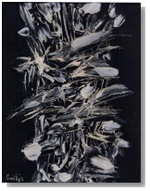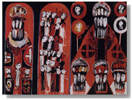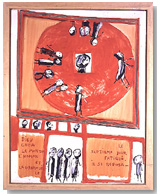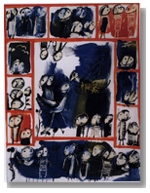![]()
|
|
 The assassination of freedom |
 Untitled, oil on canvas |
|
|
|
 Holy Fathers |
 God created the world, the man and the frog |
|
|
|
 Untitled |
1. Skaltsa Matoula, with an introduction by Tsouchlou Dimitra Art Halls in Greece: Athens, Thessaloniki, 1920-1988. Editions Apopsi: 1989, p. 26.
![]() Back to text...
Back to text...
2. According to E.Vakalo, since 1940 any communication with abroad was interrupted and it was impossible to follow the artistic actuality anymore. The Features of Post-war Art in Greece: Abstraction, Athens, 1981, vol.A', p.32.
![]() Back to text...
Back to text...
3. Gaitis' microcosm, which is initially depicted upon a uniform surface, is subsequently cut up, creating, thus, multiple representations, placed in different structural fields inside the same work.
![]() Back to text...
Back to text...
4. Gaitis frequently refers to Greek civilization, from which he draws morphological and thematological elements. In the eighties, the series "Antiquities", which is worth being studied separately, includes well-known works by the artist, that borrow representations from specific vases. The painting with the title "Pandora's box", for instance, depicts the same scene, found in a red-figure lecythus of the early 4th century from Apulia in N.Anatolia, which Gaitis has adjusted most harmoniously to his standardized, geometrical style.
![]() Back to text...
Back to text...
5. Serafini Giuliano, Yiannis Gaitis, edit.Medoussa, Athens, 1988, p. 126. In 1964 Gaitis also participated in an exhibition with the title "La Nouvelle Figuration de l' Ecole de Paris" -at the gallery Relevo in Rio de Janeiro; subsequently, he took part in various international exhibitions, relative to the theme of "narrative representation".
![]() Back to text...
Back to text...
6. An exact dating of Gaitis' works is difficult, as he seldom added dates to his signature after the early geometrical period, while he frequently returned to his older morphological investigations.
The catalogue of his retrospective exhibition that took place at the National Gallery in 1984, contains works with the expressionistic profile, dated since 1963. In the same catalogue, the then director, Dimitris Papastamos, refers to this motif, placing it around 1967 [p.9], a date accepted by the art historians Popi Panagiotou [Tribute to Yiannis Gaitis, Vafopouleion Cultural Centre, Dimitria, 1994] and Giuliano Serafini [Ibid., p.50]. This chronology seems to me more credible, since Gaitis, in 1963, was still elaborating actively the code of the imaginary microcosm.
![]() Back to text...
Back to text...
7. One of the first, at that time important, treatises on Gaitis bears exactly this title [N.Papadakis, Yiannis Gaitis: A revolutionary creator, edit. Polyplano, Athens, 1980].
![]() Back to text...
Back to text...
![]()